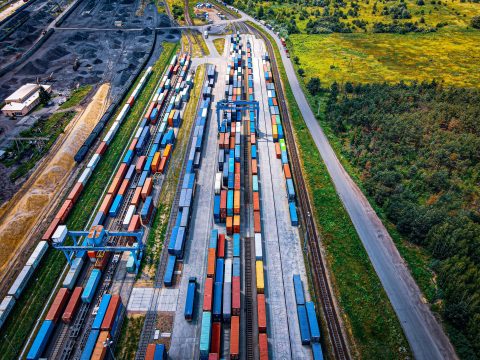Britain’s energy milestone is a landmark for rail freight

In the UK, the home fires are no longer burning. It really is the end of coal. Although rail delivered the last load on 28 June, yesterday, the furnaces at Britain’s last coal-fired power station finally shut down. Ratcliffe-on-Soar, a vast landmark power station directly adjacent to East Midlands Parkway station in the East Midlands of England, damped down the fires for the last time at midnight on Monday, 30 September.
Britain has become the first industrialised nation in the G7 to divest itself of all coal-fired power generation. Environmentalists have applauded the news that Ratcliffe-on-Soar Power Station ceased burning coal. For rail freight, it symbolises the final divestment of what was once the mainstay of the entire rail industry.
Coal trucks in every town
GB Railfreight had the distinction of delivering the last shipment of coal back at the end of June. It went to the last coal-fired power station still operational in Britain. The imported load was delivered with much ceremony on that summer day, in what would have been part of an industrial ritual going back almost two hundred years. Coal from a myriad of British collieries would be stockpiled in the warmer months at Ratcliffe-on-Soar and its forerunners in readiness for the higher demand of the winter months.
Vast coal reserves sustained Britain through the Industrial Revolution. Much of today’s railway network was built for the transportation of coal. Coal was the primary source of domestic heating right up until the late 1960s. Vast marshalling yards distributed coal trucks to local sidings in almost every town for use in domestic heating. Coal was also the fuel of railway motive power. It underwrote Britain’s heavily industrialised manufacturing-based economy.
Coal not quite abdicated elsewhere
The UK has set very stringent net-zero carbon targets. The milestone of eliminating coal-fired energy generation has been a top-level goal. It has, however, been said that the reliance on heavy industry has only been exported. Britain enjoys a cleaner environment, only at the expense of ‘exporting’ much of its manufacturing abroad. This radical economic shift has had equally transformational implications for rail freight. Where coal was king, now it is the intermodal box on the throne. Almost half of all UK rail freight is intermodal traffic.

The picture differs elsewhere, including the G7 group of industrialised countries. Large coal contracts in Europe, like the recent deal signed by PKP Cargo in Poland, are still commonplace. In Asia, Japanese coal production has bottomed out at half a billion tonnes per annum, with much of that transported by rail. In North America, both in the United States and Canada, coal traffic is still a multi-billion dollar business. Although sharply declining, coal is still around 15 per cent of all freight moved – although even here, intermodal accounts for about three times as many carloads, around 13 million units, according to the Association of American Railroads. In Britain, Ratcliffe-on-Soar was the end of the line.
You just read one of our premium articles free of charge
Want full access? Take advantage of our exclusive offer




